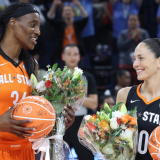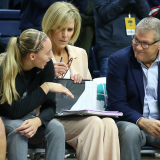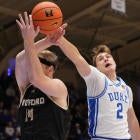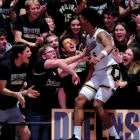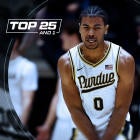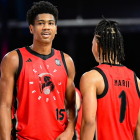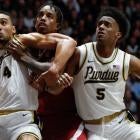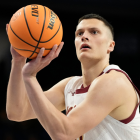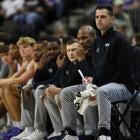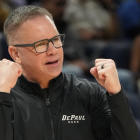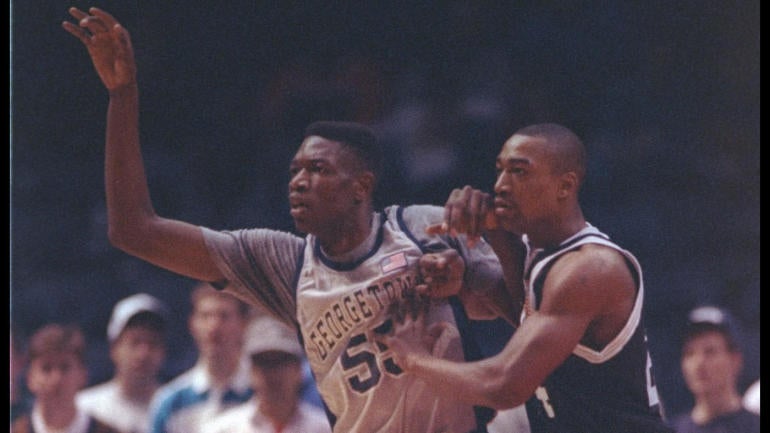
Former Georgetown and NBA star Dikembe Mutombo, a defensive menace whose rim protection and famous finger-wagging celebration made him one of the faces of defensive basketball in the 1990s and early 2000s, died on Monday from brain cancer, the NBA announced. He was 58 years old.
Mutombo was a one-of-a-kind shot-blocking extraordinaire who almost never became one at all, making his rise into one of the most impactful players of his generation -- and a Hall of Famer -- all the more improbable.
Originally from the Democratic Republic of Congo, Mutombo attended Georgetown on academic scholarship with intentions of becoming a doctor. It didn't take long for his big 7-foot-2 frame to be recognized at the highest level, though. Legendary coach John Thompson contacted him within a week of his arrival and expressed interest in recruiting him to play for his basketball team. It wasn't until the next year that Mutombo obliged, however, marking the start of a trajectory that changed Georgetown basketball and Mutombo's life.
"It was a week after I arrived in the U.S. at Georgetown. There was a student who came to get me, and they said that the basketball coach wanted to meet me," said Mutombo in 2020 in an interview with the NBA on TNT of John Thompson. "They took me there at McDonough Gym. When I realized that this tall, giant man walked out the door and looked at me and said, 'How you doing son?' I got so scared, and I just panicked. I didn't know he was that big. It was the first time for me to see somebody that tall and look someone eye to eye with a crazy look and say, 'Hey, how you doing? Welcome to the United States of America.'"
'Rejection Row' a highlight for Hoyas
After arriving at Georgetown in 1987, Mutombo tried out -- and made -- the Hoyas and Thompson's team in 1988. He wasn't an instant star, but he was instantly impactful, finishing with 2.3 blocks per game in his first year -- including one contest where he recorded 12 blocks. He was also a key figure in a meteoric cultural rise of ruthless rejections alongside teammate Alonzo Mourning. At home games played inside the Capital Centre, fans set up a special cheering section to celebrate blocked shots by posting hand cards for each block called "Rejection Row."
That year, Georgetown led the Big East with 9.1 blocks per game as a team -- more than three blocks per game more than the next-best team in the league in that category. It was more than double the per-game block averages of the leading teams in that category in the Pac-10, Big Ten and SEC conferences, and more than any other league in America at the time. That held true again in 1989-90 and in 1990-1991, as well. Rejection Row was the place to see the best shot-blocking show in America.
A tip from a government official
As Mutombo figured himself out as a player and developed -- which came fast for someone who preferred soccer and picked up the game later in adolescence -- he transformed into an unstoppable force. In the 1989-90 season, he led Georgetown in rebounds (10.5) and blocks (4.1) per game playing alongside All-American Alonzo Mourning. He did the same the following season with per-game totals of 12.2 rebounds and 4.7 blocks, all while leading the team as a senior in scoring at 15.2 points per game.
It was only by chance that Thompson stumbled upon Mutombo to begin with. The 7-foot-2 frame had to have been tough to ignore, sure, but Thompson later admitted he found him after being tipped off by a government official about him, almost as if the government knew before anyone else that his sweet feet and long wingspan might change the game of basketball in that era.
"A gentleman from a government agency here in Washington walked in and told us about him," Thompson later told the Los Angeles Times. "I guess the guy had sent a note, but you get a lot of notes. You get pictures from overseas that are very deceptive. If the kid stands back away from the basket and holds the ball up and you take a picture of him, it looks like he's taller than he is. We get a lot of those.
"But we were having summer league at the time. And I showed the guy (7-foot) Ben Gillery, who was out on the floor. And I asked him if (Mutombo) was as tall as Ben Gillery. And he said, 'Taller.' Right away, my interest level changed."
That was 1989. Thompson at that time believed he could be as good, or better, as Mourning, who was the No. 1 recruit in a class that included Christian Laettner. He might've been right.
How good were the Hoyas?
John Thompson and the Hoyas were an enduring force in the 1980s thanks to Thompson's keen eye for talent in big men. In 1981-82, a freshman named Patrick Ewing arrived on the stage, helping eventually drive the team to a national title in 1984. Then in 1988 he hit big again -- at the same time -- with Mourning and Mutombo joining the team together. They led the Hoyas to a Big East title in their first season and to the Elite Eight in 1989 and a final ranking in the AP Poll of No. 2. It was a decade marked by Hoya excellence, with the team winning 293 times and losing 76 times from 1979-80 to 1989-90 -- an average of 26.6 wins per season that ranked top five among college hoops teams of the decade.
Kind-hearted and philanthropic-focused work
The fun in Mutombo becoming a relentless rejector at the rim with a cold-blooded celly to boot came in part because of the striking dichotomy between who he was off the court vs. on it. He was a joyous person with a bubbly personality and a big heart. He devoted much of his life to philanthropy work after his playing career finished, and served on the boards of the CDC, Special Olympics International, the National Constitution Center and the National Board for the U.S. Fund for UNICEF, among others. One of his many enduring legacies was his role in helping build a hospital in Kinshasa, the capital city in the Democratic Republic of the Congo, through the Mutombo Foundation he founded.
"Dikembe Mutombo was simply larger than life. On the court, he was one of the greatest shot blockers and defensive players in the history of the NBA," said NBA Commissioner Adam Silver on Monday. "Off the floor he poured his heart and soul into helping others.
"There was nobody more qualified than Dikembe to serve as the NBA's first Global Ambassador," Silver added. "He was a humanitarian at his core. I had the privilege of traveling the world with Dikembe and seeing first-hand how his generosity and compassion uplifted people. He was always accessible at NBA events over the years -- with his infectious smile, deep booming voice and signature finger wag that endeared him to basketball fans of every generation.
"Dikembe's indomitable spirit continues on in those who he helped and inspired throughout his extraordinary life. I am one of the many people whose lives were touched by Dikembe's big heart and I will miss him dearly."





